I am black, I have spent time in a mental hospital, and much of my adult life, for both sexual and social reasons, has been passed on society’s margins. My attraction to them as subject matter for fiction, however, is not so much the desire to write autobiography, but the far more parochial desire to set matters straight where, if only one takes the evidence of the written word, all would seem confusion.
– Samuel Delany, The Straits of Messina
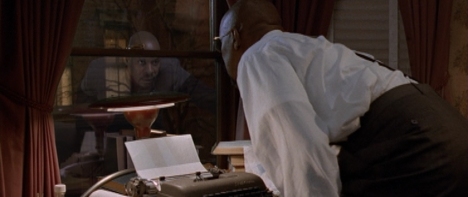
Keep dreaming.
Far Beyond the Stars is a masterpiece.
It is one of the best episodes of Star Trek ever produced, a neat encapsulation of the franchise’s core beliefs and humanist values filtered through a utopian lens. It is a story built upon the idea that things get better, that circumstances improve, that hope wins out. It is hard to imagine an episode of the franchise that more effective embodies this philosophy. Far Beyond the Stars is a love letter to the transformative potential of science-fiction, an ode to the capacity to imagine a world that is better than this one.
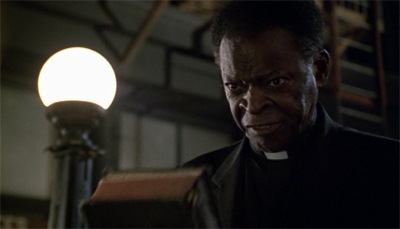
Star Trek sometimes gets a little preachy.
There is some irony that Star Trek: Deep Space Nine should be the series to deliver this particular story. After all, the writing staff on the show have long championed their position as the “bastard stepchild” of the franchise, taking every opportunity to subvert and undermine a lot of what fans take for granted about the fifty-year-old pop culture institution. Deep Space Nine is the version of Star Trek where currency still exists, where war still rages, where terrorism still occurs. So there is something surprising in seeing something as pure as Far Beyond the Stars.
Deep Space Nine is a series notable for cheekily toying with the assumptions that Star Trek fans have about the Star Trek universe. In Past Tense, Part I and Past Tense, Part II, the series reminded audiences that things would likely get worse before mankind could usher in the franchise’s utopia. In Homefront and Paradise Lost, the series implied that Starfleet was just as much a threat to Federation values as the looming Dominion invasion. Sisko crossed ethical lines that Kirk or Picard would consider sacrosanct in episodes like For the Uniform or In the Pale Moonlight.

Things PADDs.
However, Deep Space Nine has never been quite as cynical about the franchise’s core values as many would argue. As much as Ira Steven Behr hesitated to produce Trials and Tribble-ations as part of the franchise’s thirtieth anniversary celebrations, he eventually committed and the production team gave it their all. As much as Behr might have objected to the initial plans for the Defiant in Star Trek: First Contact, he still included a nice nod to the events in In Purgatory’s Shadow.
The writing staff on Deep Space Nine love the franchise, and its trappings. That is why they brought back old concepts like the three classic Klingons for Blood Oath or the mirror universe in Crossover. The sixth season is among the most provocative seasons of Star Trek in the franchise’s history, kicking off a two-year-long war arc that would seem to run counter to Gene Roddenberry’s wishes for the franchise. However, it remains very clear that the production team respect the franchise’s history and legacy.
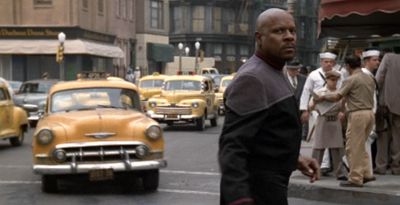
City on the Edge of Tomorrow.
Far Beyond the Stars is very much an archetypal Star Trek story. In fact, it is tempting to describe the episode as cross between The City on the Edge of Forever and The Inner Light, two episodes that can make a convincing argument for being the best episodes of their respective runs. As in The City on the Edge of Forever, the lead character finds himself thrown back to mid-twentieth-century New York, trying to reconnect with the Star Trek future. As with The Inner Light, the lead character lives an an extended adventure in only “a few minutes.”
Far Beyond the Stars unfolds against the backdrop of the fifties, which is an important era in the history of the Star Trek franchise. The original Star Trek launched in September 1966, perhaps the last gasp of the Kennedy’s Camelot. In the midst of the Cold War, Star Trek dared to imagine a future where mankind had not only survived, but thrived. However, Star Trek was just as much a product of the forties as the sixties, its perspective shaped and formed by the experience of its writers during the Second World War and by the new world order left standing in the aftermath.
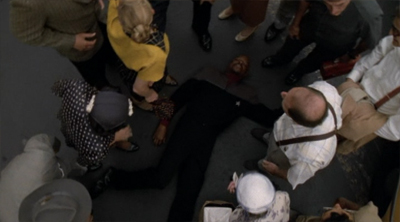
Sweet dreams.
There are certainly shades of this in Far Beyond the Stars. Like Gene Roddenberry or Gene L. Coon, it is implied that Benny Russell is a veteran of the Second World War. When Benny protests that he has “only been working at it for a few years”, Cassie corrects him, “A few years? More like fifteen, if you count all those stories you wrote in the Navy.” Benny shrugs off that writing as “amateur stuff”, but it seems clear that his vision of the future is heavily informed by those experiences.
Star Trek has acknowledged that its cultural foundations lie in the Second World War, both politically and culturally. Near the end of the show’s first season, The City on the Edge of Forever made the connection literal. Sending Kirk back to New York in the late thirties, the episode revealed that the American involvement in the Second World War was perhaps the most important event in the foundation of the Federation. This sentiment would be repeated almost forty years later with Storm Front, Part I and Storm Front, Part II at the start of the final season of the Berman era.
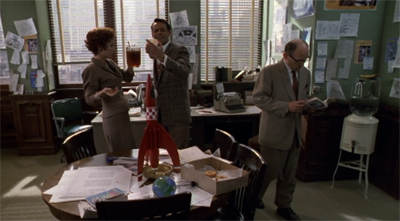
Writers’ room.
However, there is also a cultural gap that exists between the Second World War and the Kennedy administration, a period of history that inevitably led to the development and broadcast of Star Trek that stands between those two key moments in popular culture. Far Beyond the Stars plays almost as an exploration of that hidden history, of the shifts in science-fiction culture that took place between the end of the Second World War and the broadcast of The Man Trap.
Far Beyond the Stars is a celebration and exploration of the science-fiction magazine culture of the fifties that paved the way for the expansion of science-fiction into other media in the years that followed. It is story set primarily in the writers’ room of a pulpy sci-fi magazine, where the authors toil over typewriters to churn out fiction with catchy titles like “Honeymoon on Andoras” or “Please, Take Me With You.” Magazines like Incredible Tales and Galaxy recall real-world pulp like Amazing Stories or Astounding.
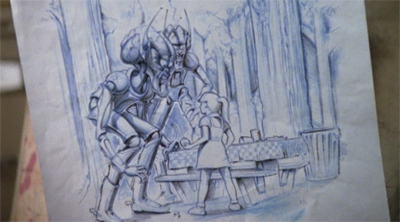
It’s no picnic…
These periodicals had a tremendous influence on the evolution of on-screen science-fiction. It seems reasonable to argue that films like Forbidden Planet would not exist without these stories, as Richard Scheib contends:
It comes with a plot that could have been taken out of any copy of Amazing Stories or Astounding in the previous decade. It is clear that the authors have read the pulp magazines of the 1940s. There is a love of science-fictional gadgetry and wondrous technology – brain-boosting devices, moving sculptures, forcefields, rayguns, the planetary energy wells and of course Robby the Robot whom one expects could quote Asimov’s Three Laws of Robotics at the drop of a mechanical hat.
Naturally, Forbidden Planet would go on to be a major influence on Star Trek, making these magazines part of the franchise’s cultural genealogy.
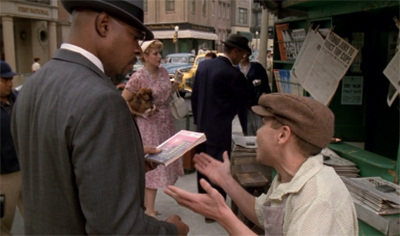
Sisko must have had quite the bump on the Nog-gin.
More than that, these magazines were home to key influences on Roddenberry. Richard Mathieson published his first short story Born of Man and Woman in The Magazine of Fantasy & Science Fiction, embarking on a career that would include a teleplay credit on The Enemy Within. Jerome Bixby was a fixture of these magazines, editing Planet Stories and publishing prose in magazines like Worlds of Tomorrow, before contributing scripts and story ideas for episodes like Mirror, Mirror and Day of the Dove.
When Benny arrives with “the new issue of Galaxy”, Herbert Rossoff rhymes a list of the authors credited on the latest edition. “Heinlein, Bradbury, Sturgeon.” Sturgeon wrote Shore Leave and Amok Time. Ray Bradbury was invited to write for Star Trek, but declined; he would be cited as an influence on J. Michael Straczynski and Bryce Zabel’s proposed reboot of the franchise. Similarly, Roddenberry invited Heinlein to write for the show, but Heinlein turned Roddenberry down; writer Manu Saadia has described Star Trek as “above all a critique of Robert Heinlein.”

The stories are out of this world…
Even the characters in Far Beyond the Stars are intended to evoke these forties and fifties magazine writers. With his interest in robotics and his distinctive pipe, Albert is clearly meant to evoke Isaac Asimov. Asimov had a very long and involved history with the franchise, enjoying an affectionate and constructive relationship with Gene Roddenberry. Hiding behind her initials to disguise her gender, Kay Eaton evokes both Star Trek writer D.C. Fontana and also magazine writers like C.L. Moore.
Even the production design of the episode is absolutely saturated with in-jokes and references that seem to position Benny Russell’s work as part of a broader cultural movement pushing towards Star Trek. Pabst’s reference to “Andoris” evokes “Andoria.” The cover to Galaxy teases the story Court Martial along with an illustration that evokes the matte backgrounds from the original Star Trek. In March 1953, Incredible Tales published The Cage, The Corbomite Manoeuvre, Journey to Babel, Metamorphosis, and Where No Man Has Gone Before.
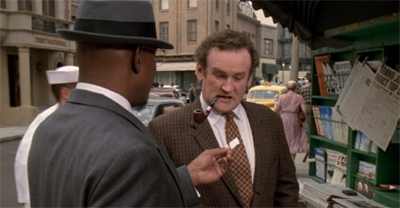
One of the nicer subtler touches of Far Beyond the Stars is how eager the cast and crew are to use the setting as an excuse to include lots and lots of smoking.
All of this suggests that Benny Russell is working at time when all the influences that will inspire Star Trek are coming into play, but they have not yet coalesced into a vision for the future. Far Beyond the Stars suggests that Star Trek had to be willed into being, that it had to come from some unconscious hunger for a better future than that suggested by the staid mood of the nineteen fifties. Far Beyond the Stars insists that Star Trek is the dream of a better future, an invocation of a world more hopeful and more idealistic than the immediate future plans to be.
Indeed, during his breakdown, Benny repeatedly insists that Deep Space Nine is real simply because he can dare to imagine it. “You can pulp a story but you cannot destroy an idea,” Benny warns Pabst. “Don’t you understand? That’s ancient knowledge. You cannot destroy an idea. That future, I created it, and it’s real.” As far as the episode is concerned, the most potent and powerful conception of Star Trek lies the way that the very idea of this utopian future speaking to “someone without a lot of hope” or “someone dreaming of a better future.”
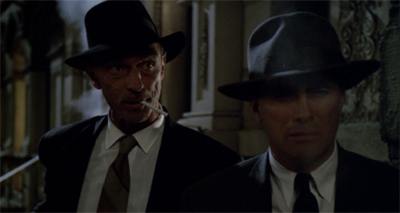
See what I mean?
It is a very romantic approach to Star Trek, suggesting that the very idea of a utopian future can be subversive gesture of resistance or empowerment. Interestingly enough, this is a theme to which Star Trek: Enterprise returns in its own final season. As the Star Trek franchise was facing cancellation for the first time in almost two decades, and as the War on Terror raged, episodes like Babel One, United, The Aenar, In a Mirror, Darkly, Part I and In a Mirror, Darkly, Part II insisted that the idea of the Federation was subversive in its own way.
There is something beautiful in the suggestion that ideas can change the world, that daring to imagine a better world has the power to change this one. In some ways, this is a very ideologically pure defence of the Star Trek franchise, one that skips past all the moments when Star Trek has fallen well short of that idealism by indulging in reactionary rhetoric or pandering to racism or sexism. Far Beyond the Stars is a stirring defence of Star Trek from first principle, contending that its shortcomings cannot undermine the hope embodied by its core premise.
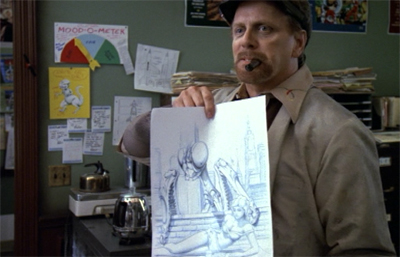
Here’s another one.
In many ways, this optimism evokes the way that writer Grant Morrison talks about the power of Superman as a very concept. Morrison has described Superman as “our greatest-ever idea as the human species”, and talked about how as a child he represented the very idea of hope in the face of annihilation:
My parents were anti-nuclear activists, so the bomb was a big frightening specter in our household. Then I discovered superhero comics and realized that here was an idea that was bigger than the bomb. Superman can withstand an atom bomb explosion. They literally saved me from the horror of the atom bomb.
There is something very pure in that idea, in the suggestion that the very act of imaging something bigger and stronger and better than the atomic bomb represented some sort of victory. Far Beyond the Stars suggests that Benny Russell finds some strength in daring to imagine a future better than that presented to him.
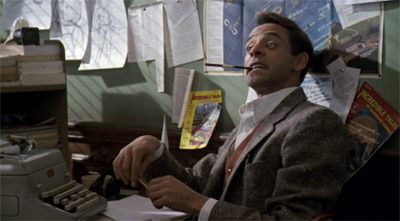
Points for variety.
Far Beyond the Stars consciously frames this utopian idealism in the context of fifties America. In particularly, the story finds Benjamin Sisko reimagined as Benny Russell, an African-American science-fiction writer working in a culture that is openly hostile to him. Benny lives in a world where successful African-American athletes cannot even live in the same neighbourhood as their white team mates, where young black men can be gunned by the police for breaking into a car, where he can be stopped and demeaned by the authorities for no reason.
Far Beyond the Stars is an episode that is consciously built around the fact that Sisko is a black man in a position of authority that would have been unimaginable to audiences less than half-a-century earlier. It is a surprisingly candid piece of social commentary, given that Star Trek has tended to dress up it commentary in metaphor and allegory. The franchise could deal with homosexuality in the abstract through episodes like The Outcast and Rejoined, but it could not produce scripts like Blood and Fire or show two members of the same gender kissing in The Offspring.
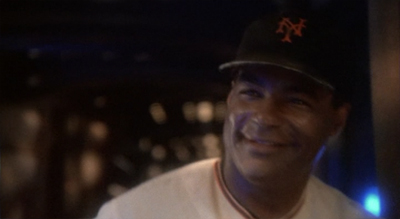
Off base.
However, Avery Brooks worked very hard to ensure that Sisko retained a distinct sense of his cultural heritage. Sisko was not written or presented in a way that was “colourblind.” Sisko was explicitly African-American, even in the twenty-fourth century. This was important to Brooks, and it inspired him to take the role:
“Certainly the fact you have a black man in a command position is very important. That is something that goes far beyond just having black people working on a show, which itself is also very important. It goes to children being able to see themselves on screen and visualize that in the future they will be doing something of importance to the world at large. It addresses the situation of having all kinds of people interacting and cooperating for the mutual survival of the planet. The writing was exceptional, and the funny thing is I initially said no to Star Trek. My wife convinced me to go to the audition. She was the one who said, ‘You can’t say no to this.’”
Sisko’s quarters are decorated with African artwork, with the writers even drawing attention to its arrival in The Search, Part I. Sisko has a long-standing interest in culinary art of his home in New Orleans, and even his casual costuming reflects a distinctly African-American heritage as compared to the casual attire of Kirk or Picard.
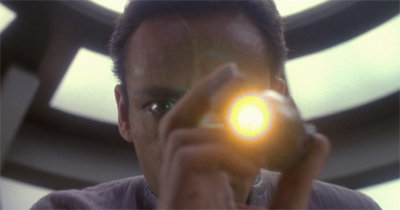
Light relief.
Deep Space Nine exists in a future where racism no longer exists, where Sisko no longer faces the sort of institutional prejudices that apply to minorities in contemporary societies. On Star Trek: The Next Generation, there was a tendency to assume that this utopia was built upon the establishment of a singular human mono-culture; that a French character like Jean-Luc Picard could speak with a British accent like Patrick Stewart, and where everybody shared the exact same values and perspective.
One of the strongest aspects of Deep Space Nine has been the emerging realisation that it is possible for cultures to peacefully coexist while retaining their own identities. Worf can partake in Klingon customs, within reason. major Kira can worship her gods in her own way. That cultural diversity trickles down to the human characters as well. Benjamin Sisko is human, just like James T. Kirk or Jean-Luc Picard or Kathryn Janeway, but that does not mean that they all share the exact same culture.
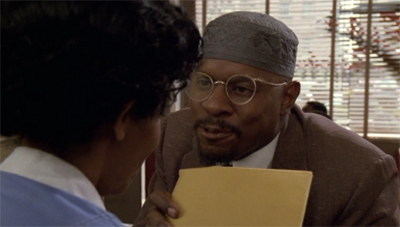
Everybody’s got a story.
Indeed, this was part of the reason why the producers asked Avery Brooks to direct Far Beyond the Stars. As Steve Oster acknowledges in the Star Trek: Deep Space Nine Companion, Brooks brings some authenticity:
“We discussed the possibility of Avery directing, knowing that he was going to be in every frame of film,” Steve Oster acknowledges. “We don’t like that combination, because it’s very hard to direct yourself. However, this was a story about racism and prejudice and we felt very strongly that it would be wrong if it came from a bunch of people who didn’t necessarily know about that experience. We knew that it was imperative to the story and imperative to the integrity of television for it to be done right.”
After all, Far Beyond the Stars was an episode about the African-American experience in fifties America, but it had been written by a bunch of white writers. Brooks was a creative individual who would put his own stamp on it.
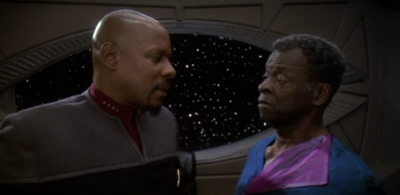
Father beyond the stars…
Indeed, Brooks worked very hard over the course of Deep Space Nine to shape and mould the character Sisko in collaboration with the writers. Ira Steven Behr has talked about arguing with studio executives on Brooks’ behalf to let him “shave his head and keep the goat”, a choice that was obviously of importance to the actor. Brooks was particularly invested in the relationship between Ben and Jake Sisko, even insisting that the producers alter What You Leave Behind so that Sisko would not be seen to entirely abandon his son.
And so it was important to Avery Brooks that Deep Space Nine recognise Sisko’s blackness, to acknowledge his cultural heritage and not to treat him as a generic television protagonist that happened to be played by an African-American actor. The result is a truly compelling and fascinating character. Sisko is never defined by his ethnicity, but his culture is very much a part of his identity and heritage. Deep Space Nine was arguably the first truly multicultural Star Trek series, and that was reflected in Sisko himself.
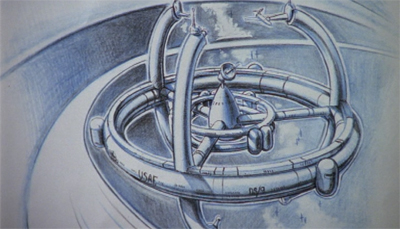
Spaced out.
Deep Space Nine has acknowledged Sisko repeatedly as an African-American, but never as explicitly as with Far Beyond the Stars. Cast into the role of Benny Russell, Sisko and the audience are confronted with reality of a prejudice and hatred based solely on a person’s skin colour. As Mark Anthony Neal argues in Looking for Leroy, Benny Russell is part of the cultural context of the genre’s mid-twentieth century history:
In terms of black science fiction writers, Benny Russell anticipates the careers of Samuel Delany, Nalo Hopkinson, and the late Octavia Butler, and brings into greater focus some of the experimental fiction of early-twentieth-century writers such as W.E.B. Du Bois, whose short story The Comet was published in 1920, and George Schuyler, whose 1930 novel Black No More centres on a scientist who is capable of turning black people white.
Russell even explicitly cites some of his contemporaries in an argument with Pabst. “What about W.E.B. du Bois, Zora Neale Hurston, Langston Hughes, Ralph Ellison, Richard Wright?” Benny demands of his editor, who claims that the public is not yet ready for “stories written by Negroes.” Benny challenges him, “Did you ever heard of Native Son?”
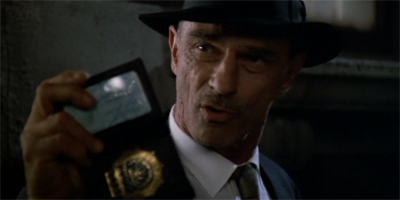
Unfair cop.
Benny is a professional. He works in a white-collar job, writing fiction that is distributed to a mass audience. He dresses neatly. He is polite and respectful. However, he is still demeaned and humiliated. Locking up after work one night, he is stopped by two racist cops. “Nice suit,” notes Mulkahey. However, the compliment comes with an accusation, “Where’d you get it?” It is a particularly nice touch that Far Beyond the Stars names its racist cops Ryan and Mulkahey, decidedly Irish names. The Irish had once been subject to such racism, but now they dish it out.
When Benny dares to imagine a future where a black man could be the commanding officer on a space station, other African-American characters scoff at his optimism. “A coloured captain?” chuckles Jimmy in disbelief. “The only reason they’ll ever let us in space is if they need someone to shine their shoes.” The black characters in Far Beyond the Stars repeatedly find themselves subject to prejudice and racism, in various forms. Sometimes, that racism is overt, as with the police officers. Sometimes, it is more subtle, as demonstrated by editor Douglas Pabst.
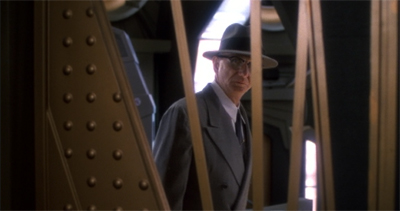
Force to pulp the pulp.
Pabst positions himself as a neutral party in this contemporary culture. He insists that he is not racist, but that he is beholden to public that is not ready for such progressive science-fiction. When Benny lists off the successful African-American writers who are allowed to embrace their blackness, Pabst dismisses his writer’s concerns out of hand. “That’s literature for liberals and intellectuals,” he reflects. “The average reader’s not going to spend his hard earned cash on stories written by Negroes.”
He pleads with Benny, “Look, Benny, I’m a magazine editor, I am not a crusader. I am not here to change the world, I’m here to put out a magazine. Now, that’s my job. That means I have to answer to the publisher, the national distributors, the wholesalers and none of them are going to want to put this story on the newsstand. For all we know, it could cause a race riot.” Pabst tries to present himself as a reasonable person with legitimate concerns, who is only operating within a larger framework. He is, as Herbert Rossoff calls him out, “a coward.”
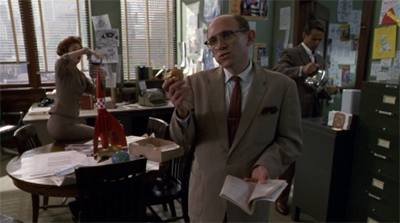
Chewing it over.
Pabst is also the face of a more subtle form of racism than the law enforcement officers who casually drop the word “boy” into conversation. He is a figure that many African American writers will recognise. Science-fiction writer Samuel Delany recognised a similar figure from his work in the sixties, as he outlined in Racism and Science Fiction:
I submitted Nova for serialisation to the famous sf editor of Analog Magazine, John W. Campbell, Jr. Campbell rejected it, with a note and a phone call to my agent explaining that he didn’t feel his readership would be able to relate to a black main character. That was one of my first direct encounters, as a professional writer, with the slippery and always commercialised form of liberal American prejudice: Campbell had nothing against me being black, you understand. (There reputedly exists a letter from him to horror writer Dean Koontz, from only a year or two later, in which Campbell argues in all seriousness that a technologically advanced black civilisation is a social and a biological impossibility. … ) No, perish the thought! Surely there was not a prejudiced bone in his body! It’s just that I had, by pure happenstance, chosen to write about someone whose mother was from Senegal (and whose father was from Norway), and it was the poor benighted readers, out there in America’s heartland, who, in 1967, would be too upset.
There is perhaps an element of self-criticism to the characterisation of Pabst. Pabst recalls those stories about David Livingston rushing down to the set to prevent two same-sex extras holding hands in The Offspring or Ronald D. Moore’s pointed observation that the only thing stopping gay characters from appearing was Rick Berman.
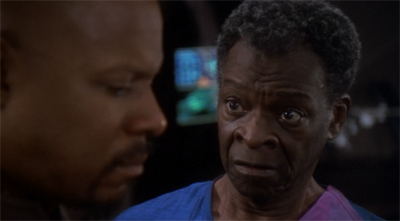
Joe knows.
It is tempting to believe that the politics of Far Behind the Stars are relatively outdated, that the experiences of Benny Russell can be consigned to the history books as an expression of closemindedness that would no longer occur. By the time that Far Beyond the Stars aired in February 1998, during Black History Month, most Americans would have hoped that the country had moved far past the bigotry and hatred that slowly chips away at Benny Russell over the course of the narrative. Things have to have gotten better, surely?
In some ways, they have. It is hard to imagine a publisher pulping an entire magazine run because the lead character is revealed to be black. Indeed, those barriers were arguably in the process of being broken down at around the same time that the story is set. The famous (and controversial) comic Judgment Day was published in April 1953, featuring a black astronaut standing in judgment of an alien society as an explicit commentary on racial prejudice. The Civil Rights movement would emerge in the later part of the decade.
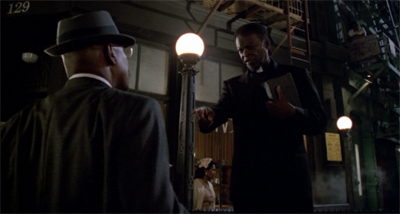
Preach out and touch faith.
Quoted in The Fifty-Year Mission, writer Ira Steven Behr acknowledges that the morality of Far Behind the Stars might seem a little awkward and heavy-handed, coming more than forty years after the bulk of the story is set:
To an extent it’s like shooting ducks in a barrel, because who the hell is going to say that racism is good at this stage of the game? So you’re kind of preaching – you would imagine – to the converted already, but I thought it was an interesting way to do it.
Behr might have something of a point in this regard, given the overt nature of the episode’s moral and the fairly unequivocal prejudice that Benny finds himself facing.
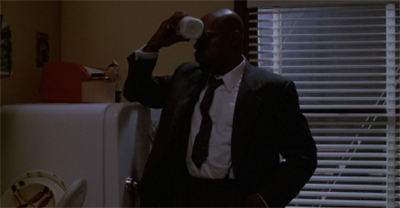
Cooler heads.
However, Far Beyond the Stars works as a cultural allegory about prejudice. More than that, it works on multiple levels. Most superficially, it works as an affectionate period piece mapping out a cultural history of Star Trek as something that emerged from the political consciousness of the fifties and sixties. Star Trek was in many ways an expression of the liberalism and idealism that arose from the younger generation in response to the staid conservatism of the fifties.
More than that, Star Trek was in part driven by the response to this sort of historical prejudice and long-standing injustice. Star Trek certainly had its flaws and its blind spots in this regard. It struggled with how best to embrace youth culture in episodes like This Side of Paradise or The Way to Eden; it repeatedly did an injustice to Uhura in scripts like The Changeling or Plato’s Stepchildren; its sexual politics were decidedly muddled in episodes like Dagger of the Mind or A Private Little War. However, the series was very earnest in its desire for a better world.
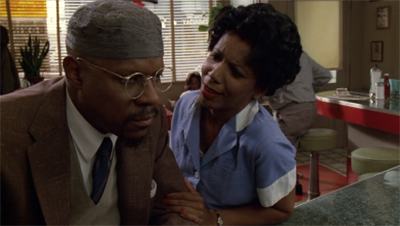
A Cass act.
This was particularly apparent in the third season, with preachy idealistic episodes like Let That Be Your Last Battlefield and The Day of the Dove. In Yesterday’s Enterprise, Jan Johnson-Smith argues that this is a valid context for Far Beyond the Stars:
The episode confronts America’s history of bigotry and the dreams of its population for equality by contrasting it with the equality of the ‘real’ Deep Space Nine diegesis and characters with which we are familiar. The significance of Russell/Sisko being ‘the dreamer and the dream’, and the parallels with the famous ‘I have a Dream’ speech of martin Luther King in January 1963 are hard to miss. The episode also confronts its own series’ history, the dream of equality and the dream of the future; as Michèle and Duncan Barrett say, ‘the dream is the dream of science fiction: it is an analogy for Star Trek itself.’ The concern is whether the dream is aspirational or delusional.
In its exploration of the political and cultural climate of the fifties, contrasting it with the idealism of the Star Trek universe, Far Beyond the Stars provides a powerful and compelling historical context for the franchise. This is a perfectly reasonable argument.

His dreams shot to hell.
However, there is more to it. The United States might have moved past the more overt racism on display in Far Beyond the Stars, but the truth is that far too much of the episode still resonates. Drawn to gunshots, Benny finds himself standing over the body of Jimmy. The young black man was killed by two trigger-happy cops. “He had a weapon,” Mulkahey insists. “A crowbar?” Benny protests. It recalls the high-profile murders of young black men by law enforcement in recent history, many of whom were unarmed.
Contemporary society might have moved past the stage where a black (or female) science-fiction writer is news, but not everybody has been accepted. Star Trek waited fifty years for an explicitly gay regular character, with Hikaru Sulu in Star Trek Beyond and Lieutenant Stamets in Star Trek: Discovery. Marvel Comics has argued that their audience simply does not want prominent female or minority characters. GamerGate exists as a backlash against feminist critics of popular culture, chasing them out of a predominantly male space.
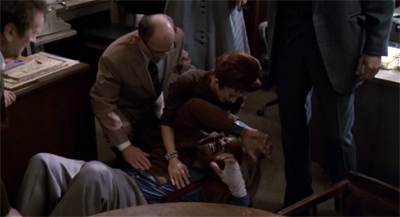
He won’t take this lying down.
There are probably a lot of contemporary writers and journalists who will empathise with the plight of Benny Russell, having been shouted down by angry mobs and hounded by those opposed by perspectives beyond their own. Female gamers are frequently subjected to rape and death threats for presuming to intrude into the medium. Recent months have seen Jewish journalists targeted with anti-Semitic rhetoric and imagery for daring to comment on contemporary politics.
Sadly, progress is not always assured. The horrors of fifties racism cannot be brushed aside and forgotten, even if the particulars have changed. “Every time I achieve a real victory, something like this happens and everything seems to turn to ashes,” Sisko reflects early in the episode, and it is hard not to empathise. The election of Barrack Obama as the first African-American President of the United States was supposed to signal a new post-racial moment for the United States. Instead, paranoid response to his presidency sparked the creation of white identity politics.
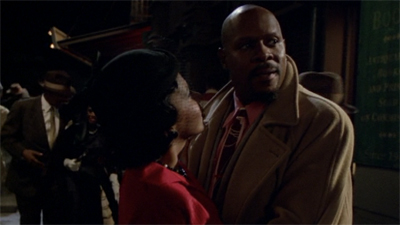
Russelling up some social change.
Much less seriously, there is still a culture of consciously downplaying the race and gender of the writers of genre fiction. A striking example from recent history is the pen name of “J.K.” for author Joanne Rowling. Rowling is author of the best-selling Harry Potter series, but her publisher suggested she initially disguise her gender:
Bloomsbury, the publishers of the Harry Potter series, said the author took her grandmother’s name. A spokesman said: “Clearly it was not her name given at birth but it could have been her confirmation name. When we asked her for her initials, she said J K.”
She added that the publishers decided to use initials instead of a name to attract boy readers. “As it happened the first book was such a success that within two months of publication she was on Blue Peter, so it was blown. There are many examples of authors changing their names.”
There is something very disheartening in this. Rowling is undoubtedly one of the most successful authors of the twentieth and twenty-first centuries. However, it was still deemed advisable that she conceal her gender in order to avoid alienating her potential audience.
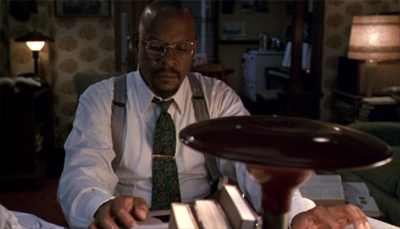
Against type.
Even in the context of the nineties, far removed from the overt racism of the fifties, it should be stressed that Benjamin Sisko was very much an aspirational figure. African-Americans were under-represented as television leads at the time. Writer Steven Barnes argued that white viewers had to be prepared for Brooks as a Star Trek lead, that the character was cautiously introduced in a way so as not to threaten white audiences:
I have enjoyed DS9, and felt that they soft-pedaled Sisko for the first few seasons, bringing him slowly to a more and more macho characterization. They knew the audience had to be carefully primed to accept such a thing. Avery Brooks is marvelous. Virile, intelligent, humorous-what a waste that A Man Called Hawk show was! He was EASILY the best thing about Spenser for Hire (which I enjoyed), and if they ever make a Spenser movie, only Brooks or Larry Fishburne could play Hawk convincingly. He is simply wonderful.
Now that Deep Space Nine has been airing for almost 6 years, what are your thoughts on the show and the character development of Captain Benjamin Sisko?
His early characterization was quite soft-spoken. I think this was no accident-they were trying to create the first African-American lead in an hour-long dramatic series. Quite a balancing act. Very slowly, they’ve let his strength-his true character-emerge.
Barnes has something of a point here. There is something disheartening about the fact that the studio took so long to fully trust Brooks to make the role his own. More than that, it is frustrating that this was still an issue in the early nineties. Far Beyond the Stars suggests that Captain Benjamin Sisko was too much for fifties readers, but there is some suggestion that nineties audiences still needed to be acclimatised and prepared.
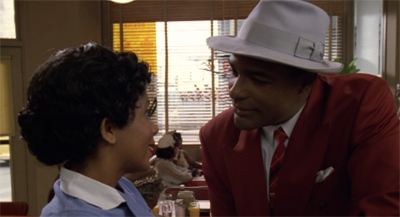
Playing ball.
To be clear, this is an issue with nineties popular culture in general and not with Deep Space Nine in particular. Shows like The X-Files and Buffy: The Vampire Slayer had predominantly white casts. Deep Space Nine has enough black cast members that it can tell a story like Far Beyond the Stars using regular and recurring players. Benny is able to interact with figures from the black community like Cassie or Jimmy or Willie or even the Preacher. It would be hard to name five regular and recurring African American actors on any other Star Trek show.
Despite the studio’s attempts to temper him earlier in the run, Brooks is absolutely phenomenal when he is given the freedom to cut loose. Brooks has a performance style that is all his own, a beautiful hybrid of the heightened staccato rhythm of William Shatner and the raw Shakespearean power of Patrick Stewart. When really cutting loose, Brooks feels very much of a piece with the heightened universe around him, a larger-than-life figure in a fantastical world. Sisko is one of the most compelling and engaging major characters in the franchise, in part thanks to Brooks.
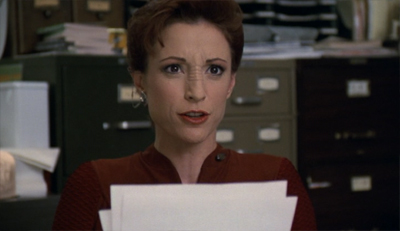
One tough cookie.
Far Beyond the Stars is very much a showcase for Brooks’ performance as Benny. Brooks brings the character to life, perfectly following Benny his numb acceptance of the status quo towards his epiphany and his embrace of the idea of Benjamin Sisko. According to Nana Visitor, his performance of the breakdown scene was something to behold:
There are only two things that come to mind. One was that I fashioned my look on a self-portrait my mother had done of herself when she was my age at that time period — and I looked eerily identical. In one of the shots I took the pose she was in — hand to chin — and it was a little secret homage to my mother. The other thing was how on-the-edge Avery’s performance was. When his character collapses, I remember being alarmed and unsure that the actor was OK. I’d never gotten scared like that for another actor’s welfare in all my experience. It was chilling to watch.
Brooks does phenomenal work in the role. In some respects, Far Beyond the Stars is his defining performance. The sheer anguish of his breakdown at the episode’s climax is perhaps Sisko’s most mimetic moment. Along with Vreenak’s “it’s a faaaake!” from In the Pale Moonlight, it is a truly iconic moment for Deep Space Nine.
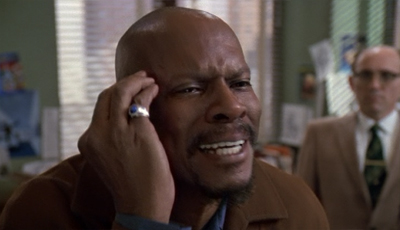
Oh, Vreenak would just love this dude.
Even beyond the power of the central metaphor and Brooks’ central performance, Far Beyond the Stars is a spectacular piece of television that has been put together with a great deal of care. The fifties setting of Far Beyond the Stars might have been intended to support a single episode, but the writers and the production design team put a lot of effort into fleshing out the world. The Paramount back lot looks beautiful, filled with vintage cars and loving recreating the period décor.
It speaks to how well Far Beyond the Stars is constructed that all of the characters in this vision mirror their Star Trek counterparts in some way or another, with even this dreamscape serving to illuminate some of the core character beats on Deep Space Nine. There is some fundamental truth in how Far Beyond the Stars portrays these characters, making it seem like more than just a clever throwaway. For example, Pabst is very clearly designed to mirror the character of Odo. Pabst may not literally be Odo, but he reflects some of Odo’s core aspects back.
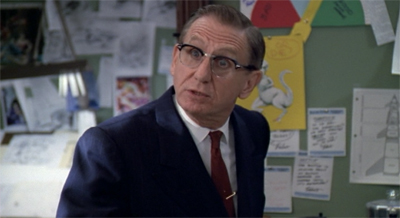
Blast from the Pabst.
Like Odo, Pabst is primarily motivated by a pursuit of order rather than justice. Like Odo, Pabst is willing to tolerate a perpetual state of injustice so long as the appearance of order is maintained. Pabst and Rossoff fight over the donuts, a regular occurrence fought to “a draw, same as always.” Like Odo and Quark, Pabst and Rossoff represent the opposite ends of the ideological spectrum. Pabst represents the establishment, but without any real underlying moral core. Rossoff is very much the quirky outsider, but with a surprisingly strong moral character.
Rossoff labels Pabst a “fascist”, and he might not be wrong. Pabst’s collaboration with the powers that be perhaps mirrors Odo’s compromise with the Cardassians during the Occupation, as explored in Necessary Evil and Things Past. Odo has always been the most morally flexible character in the Deep Space Nine ensemble, and that is reflected in Pabst. In many ways, Pabst betrays his writers like Odo betrays his friends in Children of Time or Behind the Lines. Pabst is a certainly very interesting read on Odo.
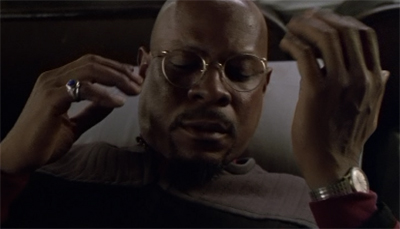
Dressed to impress.
There are parallels with other characters, of course. Rossoff is very clearly a twisted reflection of Quark. He takes offence to Pabst calling him “a pinko”, but the truth is that Pabst might have a stronger conscience than the rest of the writing room. This is the central irony of Quark. Deep Space Nine has repeatedly suggested that Quark is not nearly selfish and greedy enough to be a Ferengi, with episodes like Business as Usual and The Siege of AR-558 suggesting that Quark has a much stronger moral centre than most of the other characters would acknowledge.
Reflecting Bashir, Julius is a bit of a snob. “White Rose Redi Tea,” he muses after his wife makes some instant tea. “What an appalling concept.” When K.C. insists that “H.G. Wells would’ve liked it”, Julius rejects the idea out of hand. “I doubt that. No self respecting Englishman would.” Like Martok, Roy is gregarious and larger-than-life. When the writers object to the buxom beauty in his sketch for “Honeymoon on Andoris”, he shrugs, “So I had too much sauerkraut on my franks that night. What can I say?”
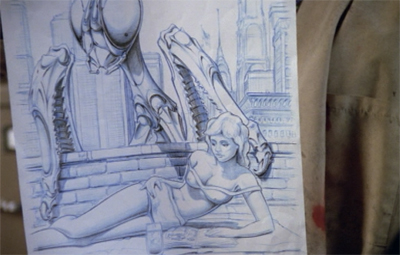
Insect appeal.
Beyond Pabst and Rossoff, perhaps the most insightful character commentary comes in the form of Albert Macklin, who is mirrored with O’Brien. In the world of Deep Space Nine, the decency of Miles Edward O’Brien is treated as a universal constant. It is that basic decency that bleeds over to the mirror universe in episodes like Through the Looking Glass and Shattered Mirror, and which makes the obligatory “O’Brien must suffer” episodes so compelling. It is no surprise that Albert Macklin seems like the nicest guy on the writing staff.
More than that, Far Beyond the Stars suggests that Macklin shares O’Brien’s interest in technology. “Albert’s got the right idea,” Pabst advises Benny. “He’s not interested in negroes or whites. He writes about robots.” In fact, Macklin even seems to share his counterpart’s desire to fix things. While the entire staff argues over Pabst’s refusal to publish the “Deep Space Nine” stories, it is Macklin who ultimately proposes a solution. “I’ve got an idea,” he suggests. “Why not make them, you know, a dream?”
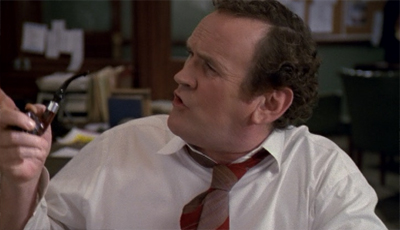
Put that in your pipe and smoke it.
This is quite clever of itself, but Far Beyond the Stars goes a little further. It suggests that Macklin is primarily interested in robots and machines because he has difficulty interacting with people. He is incredibly socially awkward, from his introduction to Benny at the start of the episode. “I thought you might be going… eh… to the… office…?” he asks Benny. He stutters repeatedly. When Rossoff takes a cheap shot at Macklin for writing about robots, he responds, “I like robots. They’re very efficient.” The implication is that humans are… not.
This is interesting in the context of O’Brien, if only because it seems to hint at a nice little character detail. Episodes like Empok Nor have repeatedly insisted that O’Brien became an engineer because he did not want to be a soldier any longer. The implication would seem to be that O’Brien liked fixing things instead of destroying them. However, through the character of Macklin, Far Beyond the Stars asks the audience to consider whether O’Brien is more interested in mechanics because they are fundamentally simpler than people. They lack the complications.
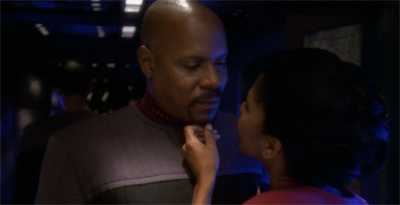
Star-crossed lovers.
However, the character seem to exist in a space between the Star Trek universe and the real world. The characters not only mirror their Deep Space Nine counterparts, but also the actors. As The Star Trek: Deep Space Nine Companion demonstrates, the sets were populated with lots of little in-jokes and references:
Visible everywhere are pinned-up memos from Mr. Pabst. One memo to Albert Macklin advises him that “four laws of robotics is too many”, and suggests that he lose one. The memo brings to light the similarity between Albert and famed science fiction writer Isaac Asimov, who wrote a series of novels in which robots operated according to three “Laws of Robotis.” Asimov’s groundbreaking novel, I, Robot was published by Gnome Press, as was Macklin’s first novel. Another Pabst memo, this one to Herb Rossoff, advises that “no one would believe that a cheerleader could kill vampires.” This inside joke works on two levels, given that Rossoff’s counterpart, Armin Shimerman, appeared for several seasons on the series Buffy, the Vampire Slayer.
Armin Shimerman cites this little in-joke as “the only time the production or anyone (except the actors) ever acknowledged my other existence on Buffy.” It is a very clever reference to Shimerman’s career beyond Deep Space Nine.
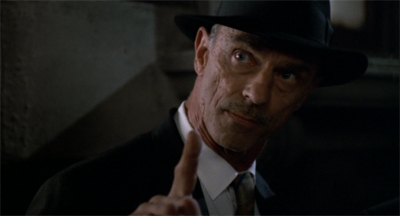
Another nice touch: of course twentieth century Gul Dukat has a scuzzy mustache.
Indeed, Rossoff’s advocacy for Benny could be seen as a nod to Shimerman’s off-screen advocacy. Shimerman is one of the most socially-conscious members of the Deep Space Nine cast, having served for six years as a member of the National Board of the Screen Actors’ Guild and serving as the organiser (and representative of) the Trek Against Trump campaign in late 2016. It makes perfect sense that Shimerman would be cast as the member of the Incredible Tales writing staff most sensitive to Benny’s plight.
Less seriously, there is something very clever in casting Nana Visitor and Alexander Siddig as a married couple. The two actors got married during the fourth season of Deep Space Nine, and had started a family together. Although the marriage did not last, the Deep Space Nine writing staff would work in a number of sly references to the relationship over the final four seasons of the show. In Fascination, the two characters almost hook up. In Apocalypse Rising, Kira blames Bashir for her pregnancy. Far Beyond the Stars takes the in-joke to its logical conclusion.
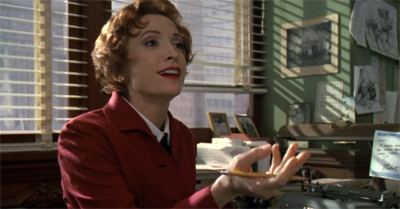
Oh, Kay.
Far Beyond the Stars is a remarkable piece of television, and it made an incredible impact on both the writers and the fans. Indeed, the concept of Benny Russell was so striking and effective that the production team even returned to it for a few scenes in Shadows and Symbols, drafting in Casey Biggs to play a fifties equivalent of Damar. The fifties setting has even been used in tie-in fiction, making an appearance in the Millennium trilogy along with Unity and Raise the Dawn.
Most strikingly, the writers even considered returning to Benny Russell at the very end of Deep Space Nine. The intention would obviously have been to pay-off the suggestion that Benny Russell was both “the dreamer and the dream”, that he was every bit as real as Sisko and that the two characters were somehow recursive. Perhaps all of Deep Space Nine existed inside the mind of Benny Russell, while Benny Russell existed inside the mind of Benjamin Sisko. It certainly would have been a sly and winking ending, bordering on cheeky.
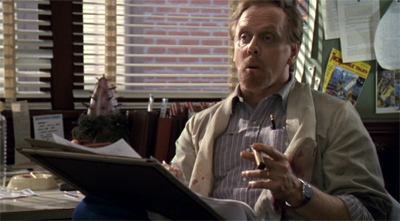
The art of pulp.
Ira Steven Behr argued in favour of this ending, but lost. According to The Fifty-Year Mission, one of the deciding factors was the existence of a larger shared universe:
At one point I pitched the idea that at the end of the series everything would have been from the imagination of Benny Russell. Of course, they wouldn’t let me do that idea – it would have taken away the entire franchise. But what’s so crazy about the idea that DS9 was part of Benny’s mind? It’s part of Rick Berman’s mind and Michael Piller’s mind and my mind, Robert’s mind, Hans’ mind, René’s mind, and Ron’s mind. So, of course it’s part of someone’s mind.
Behr makes a very valid point, and there is something to be said for expanding the theme of Far Beyond the Stars to encompass all of Deep Space Nine and arguably all of Star Trek.
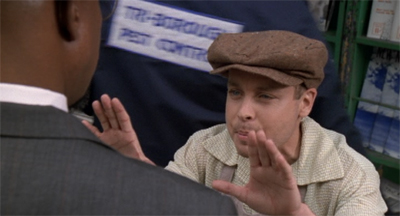
I read the news today, oh boy…
There is a lot to be said for Behr’s argument. Star Trek is not real. It is a multimedia franchise. It is not a documentary from the future, it is a drama that is authored by staff writers. Given the almost mythic quality of the franchise, and its unique place in popular consciousness, there is something to be said for suggesting that the strongest interpretation of Star Trek is the dream of a hopeful future from somebody who has lived in a world without that hope or that dream.
Of course, there any number of counter-arguments. A dream ending might be seen to undercut all of the stories that came before, particularly undercutting any sense of tension or drama. While the audience is aware that Star Trek is not real, actively reminding them of that fact at the very end of the last episode would seem the perfect way to sour the mood. More than that, revealing the entire franchise to be an extension of Benny Russell’s imagination would arguably be the sort of sly twist that Behr would never tolerate from any other Star Trek production team.
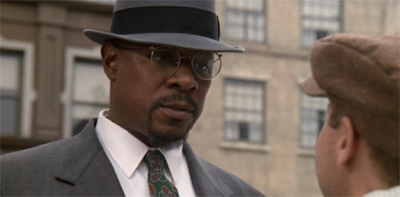
The write stuff.
Understandably, the production team were divided on the issue of whether Deep Space Nine should be considered the dream of Benny Russell. Discussing the finale with Cinefantastique, Hans Beimler opposed the idea:
Said Beimler, “At one point we were considering ending the series with Benny Russell walking the station, what he had imagined. But Benny Russell was something that was introduced in the sixth season. It’s not an element from the beginning. It’s important that this series be a seven-year arc, not a two-year arc, so to end on that note I think would have been inappropriate. It’s an interesting way to go, but you have to look at the series in its entirety, and I think that’s why we made the decisions that we made.”
It is a fair argument. It seems unreasonable to hang the big final twist of the final episode on an episode that aired in the middle of the sixth season, ignoring the one-hundred-and-seventy-odd episodes around it.
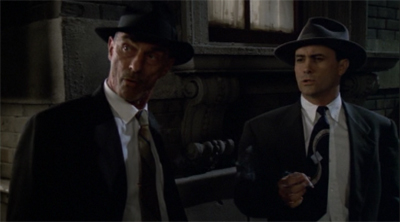
A little L-T on details…
At the same time, Beimler’s logic is not entirely convincing. After all, What You Leave Behind does not really pay off Emissary in any substantive way. Sisko’s one job in Emissary was to bring Bajor into the Federation. That narrative thread was left untied, last discussed in Rapture. If Beimler is arguing that a series finale has an obligation to go right back to the start in order to wrap up a “seven-year arc”, then the choices made by the production team do not reflect that.
More to the point, What You Leave Behind ultimately hinges on a set of plot point introduced in the fifth season and clarified in the sixth season. The Dominion War was declared in Call to Arms, but took over the show in A Time to Stand. The Pah-Wraiths were introduced in The Assignment, but the promise of an epic showdown with the Prophets was cemented in The Reckoning. However the twin climaxes of What You Leave Behind were the end of the Dominion War and the final battle with the Pah-Wraiths.
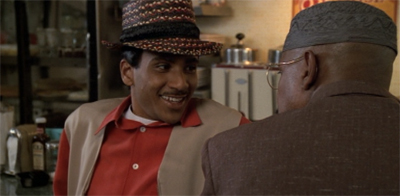
Hussling Russell.
There’s inherently nothing wrong with delivering on these more recent threads. Indeed, Deep Space Nine has been quite good at improvising as it goes, picking up plot points as it moves forward. The production team have never been afraid to drop elements that weren’t working and add new details to the overall arc. The Maquis plot was wrapped up in Blaze of Glory, while Rapture seems to put a pin in the idea of Bajor joining the Federation at any point in the near future.
With all of that in mind, there’s certainly no reason why What You Leave Behind couldn’t include a callback to Benny Russell and Far Beyond the Stars. The episode is certainly strong enough to support that eight, and deserves to be singled out as one of the defining stories from the seven-season run of Deep Space Nine. Certainly, a small shot at the end of What You Leave Behind would not feel unnecessarily intrusive. It would not be like awkwardly shoehorning William T. Riker and Deanna Troi into These Are the Voyages…
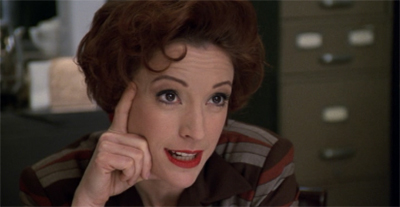
K.C. in point.
For his part, writer Ronald D. Moore always appreciated the ambiguity of Far Beyond the Stars:
My own opinion is that this is one of the best things about the episode. I always liked the idea that all of DS9 may be nothing more than the fevered imaginings of Benny Russell. I still get a kick out of the ending and think it is one of the key ingredients to elevating the show to something very special.
Perhaps that might have been cheapened by deciding one way or another at the end of What You Leave Behind.
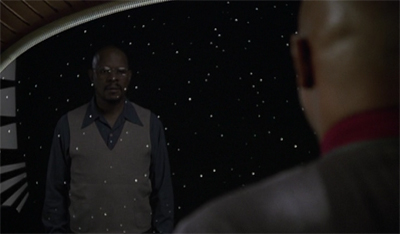
Keep dreaming.
There is something powerful in that twinned image of Benjamin Sisko staring out of the window of his quarters, looking at Benny Russell staring back from inside his apartment. Which one of those reflections is real? Is either of them? Are both? Are they both figures of some greater slumbering imagination, neither having a great claim to being “real”? If the future of Star Trek is real because Benny can dare to imagine it, does that mean that Benny is real because Sisko can dare to imagine him?
It is beautiful stuff. Like Star Trek itself, Benny is at once the dreamer and the dream.
You might be interested in our reviews of the sixth season of Star Trek: Deep Space Nine:
- A Time to Stand
- Rocks and Shoals
- Sons and Daughters
- Behind the Lines
- Favour the Bold
- Sacrifice of Angels
- You Are Cordially Invited…
- Resurrection
- Statistical Probabilities
- The Magnificent Ferengi
- Waltz
- Who Mourns for Morn?
- Far Beyond the Stars
- One Little Ship
- Honour Among Thieves
- Change of Heart
- Wrongs Darker Than Death or Night
- Inquisition
- In the Pale Moonlight
- His Way
- The Reckoning
- Valiant
- Profit and Lace
- Time’s Orphan
- The Sound of Her Voice
- Tears of the Prophets
Filed under: Deep Space Nine | Tagged: benny russell, better future, deep space nine, Dominion War, hatred, metafiction, racism, star trek, star trek: deep space nine, utopia |




















This is an excellent episode, and I always felt it was sort of DS9’s The Inner Light. In both episodes, a large part of the power has to go to the actors. When you read just the screenplay, it still works, but the power is lost a little bit. Avery Brooks’ and Patrick Stewarts’ powerful performances truly do help anchor both the episodes.
I also like that in this episode we don’t truly get an explanation for what happened. Sometimes, the most affecting moments in our lives are things we can’t really explain, and I like that the episode didn’t feel the need to provide some technobabble explanation for the events.
I will say that I have two small quibbles with this episode. One is that it feels as if the role of the female syfy writer is downplayed a little too much. I get that it is Sisko’s story, but she felt a little unfairly marginalized. The other issue I have is with Joseph Sisko’s preacher character. That felt a bit too much like the cliched mystic negro character, and I wish they could have tweaked him to make him more realistic.
William, Brock Peters is absolutely the actor you want quoting from Revelations! Casting = justified. I think it was pretty well understood to the audience (well, to me on first viewing) from his first scene that he was definitely not Joseph, something more than a preacher, and clearly speaking on behalf of the Prophets (“Praise to the word of the prophets”).
The Magical Negro is a problematic character primarily because he shows up to solve the white guy’s problems. Prophet/Joseph doesn’t solve Benny’s problems and Benny ain’t white (thank you, yes, I am Captain Obvious).
I’d argue that there’s also some nice symmetry there. Joseph is Sisko’s father. So of course he shows up as a Father (of sorts) in Sisko’s vision. It’s kinda like Odo showing up as a passive character with fascistic leanings or Quark being strangely fundamentally decent underneath a dramatic exterior or O’Brien fixing things.
I don’t know. I think Kay’s situation is made as clear as possible while keeping her a supporting player. I thought it was a nice character touch when she figures out who should be having the dream after Albert comes up with a very mechanical solution to the problem, because of course she understands what it is to dream of a better world.
I’m now watching Deep Space Nine marathon on Netflix they have all the episodes…
I hope you enjoy. It is a fantastic show.
Far Beyond the Stars is a curious diversion among DS9’s excellent sixth season, but it’s also a strong contender for not just best episode of the year, but perhaps the entire series as well. There have been episodes during this time in DS9’s history that have told stories away from the Dominion War, and while some are better than others, Far Beyond the Stars goes one better by transplanting the entire cast of characters into a whole other scenario.
The onset of the Dominion War shakes Sisko’s deepest beliefs on a number of occasions. S6 touches base with it in A Time to Stand, Far Beyond the Stars and In the Pale Moonlight until it culminates in him taking a Starfleet leave of absence in Tears of the Prophets.
Truthfully, Sisko has always had a problem with matters of faith. Losing his wife Jennifer to a Borg attack nearly led to him resigning his Starfleet commission (in Far Beyond the Stars he only considers it) as well as his continued scepticism that he’s the Bajoran Emissary. Sisko’s convictions have never been on the same page as his courage. And Far Beyond the Stars is interesting for the way it casts Sisko in the role of a man also struggling to maintain faith in the face of overwhelming opposition.
After the latest casualty of the Dominion War takes another toll on Sisko’s sanity, he suddenly finds himself living the life of Benny Russell, a frustrated SF magazine writer in 1953, dreaming of a much better future for blacks everywhere. But racism is rife, and Benny faces either doubt from his own people, or open hostility from others for even daring to dream of such things.
Benny pours his hopes, dreams and emotions into his writing, and after seeing a rough sketch of a futuristic space station, he starts envisioning the most important people in his life as the denizens of that station, and the universe it inhabits. But he can’t see any of his work in print because of the heretical notion of a black captain.
Far Beyond the Stars may seem baffling to the novice viewer, and it could be to even a seasoned Trek veteran because watching it for the first time is akin to seeing an alternate reality. But unlike DS9’s perennial Mirror episodes, where the same players are engaged in a whole different ballgame, Far Beyond the Stars takes the same idea and runs with it to somewhere far more fulfilling.
On two separate occasions, Sisko/Benny looks at his reflection and it becomes a literal window into some other life and some other world. Benny’s dreams begin to take shape in the waking world, and blur to such a degree he can no longer recognise the difference. But beyond that, it does have something to say that Star Trek is usually reluctant to – addressing the subject of race.
Trek is a multicultural franchise. TOS in particular has a command crew made up of many different nationalities. Much could be said of TNG, DS9 and VGR, that expands the net even further to include aliens, androids and holograms. But this is something usually taken at face value, and is something Star Trek doesn’t talk about. Far Beyond the Stars is the exception, and puts the subject of race in a frank perspective (Cirroc Lofton even gets to use the N-word).
Unlike the way VGR clumsily introduced misogyny to the Kazon in order to reinforce Janeway’s position as a female authority figure, Far Beyond the Stars is a surprisingly pure, open account of how difficult it is to maintain a morality when confronted by those who can’t see past a person’s race, creed or gender. The episode even literalises it by removing all of the prosthetics and funny faces, allowing each of the actors to speak from they’re hearts.
This episode contains some of the best acting spanning the entire franchise, with Avery Brooks’ impassioned breakdown at the climax particularly impressive – a scene that shows some real acting from Brooks, and should have accrued him some prizes, but he was criminally overlooked (like Marc Alaimo in Waltz).
By the end, Sisko’s experience allows him to persist with his duties, but hindsight lends the episode an added air of poignancy when subsequent S6 episodes (a season particularly hard on Sisko) show how tenuous faith can be. This is something illustrated by the episode itself when Sisko confides in his father “Everytime I achieve a real victory, something like this happens and everything seems to turn to ashes!”
When I reviewed Waltz, I said DS9’s sixth season just gets better and better. Far Beyond the Stars is proof that so too does the series as well.
It really is a beautiful piece of television.
I meant to mention this before Darren but there was no room for it – I’m glad you name-checked Richard Scheib in your review. Moria is one of my favourite websites and Scheib one of the best of online film critics. His reviews are required reading whenever I’m about to check out a new genre film and I think he’s criminally underrated. It was such a lovely surprise to see an excerpt from one of his reviews here. Thankyou Darren for shining a light on one of the most overlooked online genre contributors.
Thanks David. I try to get a broad sampling of popular culture in these reviews. Standing on the shoulders of giants, and so forth.
I always read Pabst as somewhat an analogue for Rick Berman.
There seems to be several layers of character analogues here – the regular characters (from the future) with their fictional 50’s counterparts; those 50’s counterparts with their real analogues from the 50s (Asimov, Fontana, etc); and those real 50’s scifi creators with the real scifi creators who made DS9.
Ira Behr was very canny and professional dealing with Berman, because Behr and company understand show business very well (hell, they even fetishize it). That doesn’t mean that they weren’t frustrated by Berman’s conservatism on occasion.
And I’m not one to completely dismiss Berman – he did contribute to Star Trek in positive ways. But that doesn’t negate the negative effects resulting from his decisions during his tenure of producing Star Trek.
I always remember this comment from Moore: “This is one of those uncomfortable questions I hated getting when I was working on the show, because there is no good answer for it. There is no answer for it other than people in charge don’t want gay characters in Star Trek, period. This stuff about, How would you know? Maybe there are lots of people walking through those corridors that are actually gay. What would you have us do? Show them holding hands? That would be ridiculous. Our regulars don’t hold hands, which its own kind of a sad commentary on the state of human relations, that they can’t even hold hands. Just think about what it would say to have a gay Starfleet captain. It would mean something in Star Trek. It would mean something in science fiction. It would mean something in television. Why isn’t Star Trek leading the way anymore, in the social, political front?”
This episode is a healthy dose of self-criticism. I don’t believe any of the 50’s characters were intended as exact analogous to any of the show’s writers; however, I do believe they may have been intended to reflect the writers’ attitudes towards Berman’s “no gays” policy – from outspoken denouncement (Herb), to focusing on maintaining cordiality (Julius), to quiet support for those challenging the status quo (Albert).
I don’t think this episode was primarily an allegory for the conservative politics of the Berman administration – but that is certainly what it was about in part.
When looking back on Berman’s tenure, it’s difficult to disagree with Herb Rossoff’s assessment: he was a coward.
That’s an intriguing read, actually. I hadn’t really thought of that, beyond the obvious parallel of Pabst and Berman both being very conservative stakeholders and overseers. If that’s the case, would it make Behr out to be Herb? That might also fit, given Behr’s long-standing affection for Quark.
I do allude to the cowardice regarding homosexual characters in the review, but you’re right, it might be a much bigger thing than I make it. Particularly since I wrote this review before watching Chimera, which seems very explicitly to be about the way that the Star Trek franchise’s liberalism failed with regard to LGBTQ people.
The first time Christianity is recognized in Star Trek, isn’t it? Besides that I found this show to be extremely moving and ridicilously well played. Still, the similarites of the “imagined”/50s characters to their “fiction”/ST counterparts were intriguing. The police (Weyoun/Dukat) as the bad guys, O’Brien’s affinity to robots/tech, etc. I just found the part of Dax a little unsettling – what does this tell us about Sisko’s impression of her beyond the “old man”-attitude?
And to repeat the praise of the acting. Anyone claiming Avery Brooks were a bad actor may have a look at this episode. He is so nuanced, so believable in his pain, so different and still so similar to Sisko…. Just great! You can see the pain in his eyes, you feel it.
You could argue for certain TOS episodes have shades of it, like Who Mourns for Adonais? (the whole “one god is enough for us”) and Bread and Circuses (the way they react to Christianity as the default “correct” belief system for an alien planet) as suggesting Christianity exists in the Federation. There are also certainly shades of it to the wedding ceremony in Balance of Terror, if more from the set design than the dialogue (“our many beliefs”).
But don’t forget Janeway’s “and by the powers vested in me by Starfleet Command”. Does every starship captain in the Federation have a God complex by the 24th Century?
Ha!
The war is weighing on Sisko, and the death of a friend does him no favors. It makes sense, really, considering what he’s been through and the responsibility he has on his shoulders. He’s in control of the most crucial location in the entire war-lose it, and it’s over. He’s probably something of a galactic hero to the Federation. The Prophets send him the vision of Benny Russell to reinvigorate him. “Far Beyond the Stars” is about Benny and his struggle on one level, absolutely, but it’s that combined with all the other layers that elevate it into the stratosphere. It’s a straightforward tale of prejudice, executed very well without dipping into problematic territory. It’s an ode to the power of believing in a better future. It’s a fun meta episode about the nature of Star Trek. Armin Shimerman said it best-it’s perfect science fiction.
It’s a fantastic piece of television.
If Benny could keep dreaming of a better world despite all of the obstacles in his path, then Sisko can keep on moving forward and do what needs to be done.
I like how it allows Sisko to process some of the issues he’s been sitting with all season—like, the image of Jake being killed by Dukat and Weyoun is something that probably kept Sisko awake at night for months in a way he never really let himself acknowledge.
Alexander Siddig is biracial, no? Or if he doesn’t identify that way, he is at least, a person of color. Yet his character “passed” or was not subject to the same type of discrimination that Benny was. I loved this episode but I think it would have been even stronger if there was even a line or two acknowledging that element as well. It would even reflect somehow the different type of “passing” that Bashir benefitted from as a genetically modified individual.
There are so many levels as to how this episode remains incredibly relevant, but I really love its critique of genre fans that think somehow casting protagonists with underrepresented minorities (of all types) is pandering. Representation matters!
Interesting points about Siddig and Bashir. I’d never really thought of it like that. I figured that his Britishness served to exclude him from these sorts of obvious prejudices, coupled with the fact that – like Benny before that vision – he also didn’t upset the apple cart.
Yet he is included in the cast photo, right? Pretty interesting for a Sudanese person, even a Sudanese Englishman.
Something I never noticed before is how much of this episode is Sisko being given some space to acknowledge and process some of the trauma and anxiety he must have been sitting on for a long time. For instance, the specific image of Jake murdered by Dukat and Weyoun is something that must kept him awake at night for months during Dominion control of the station.